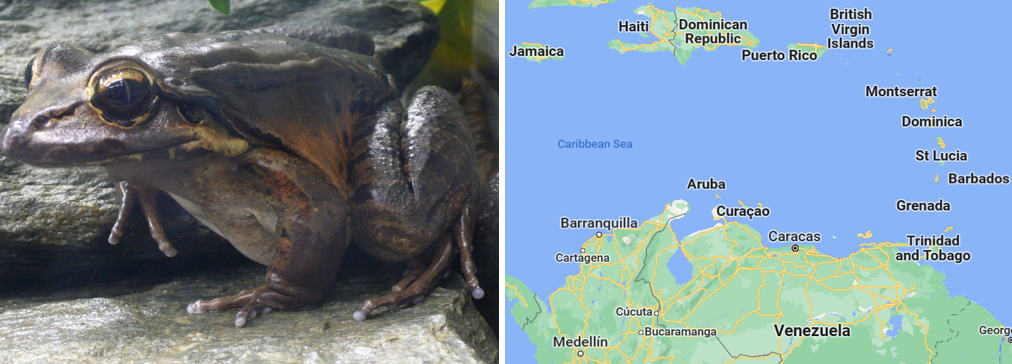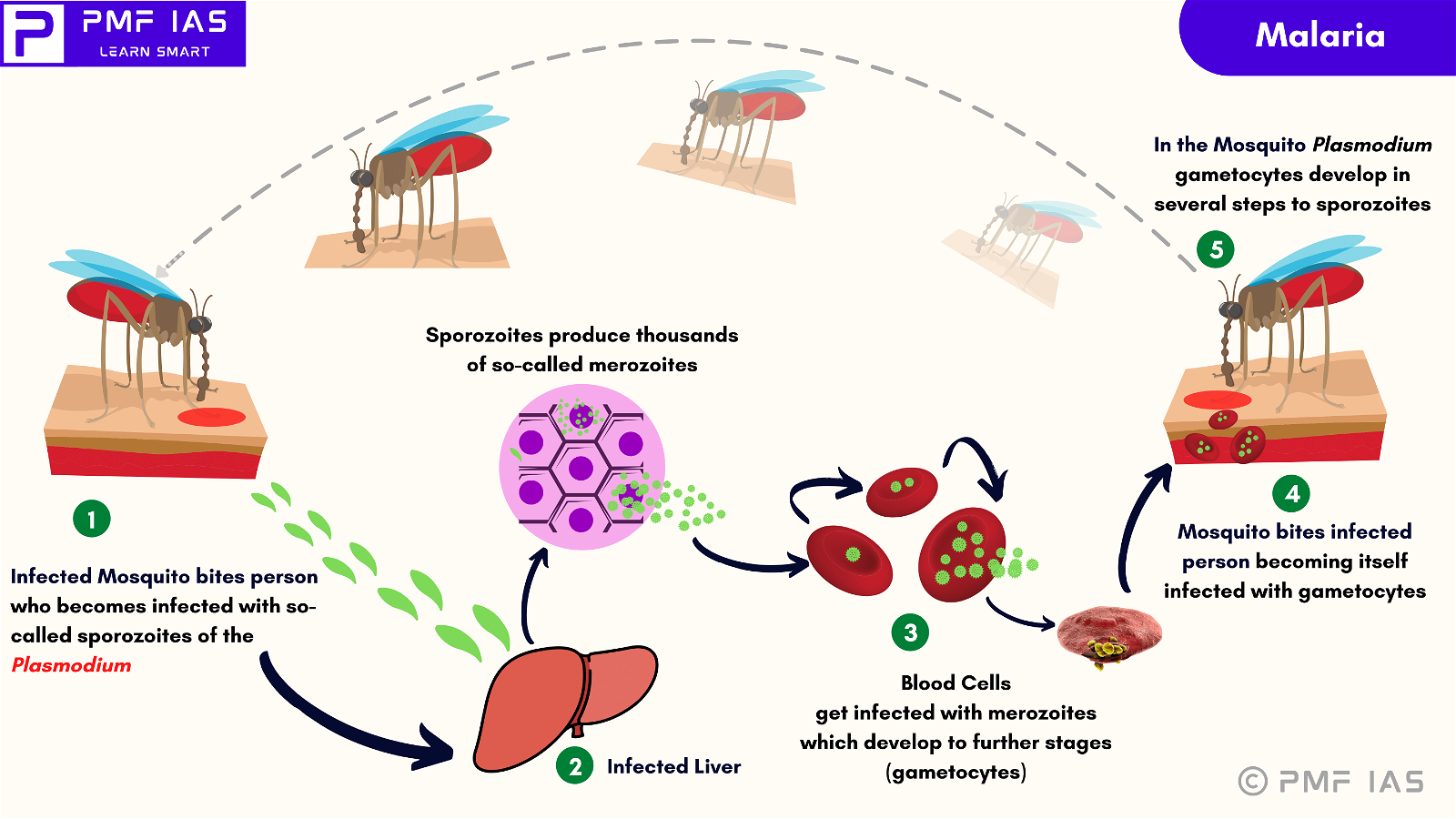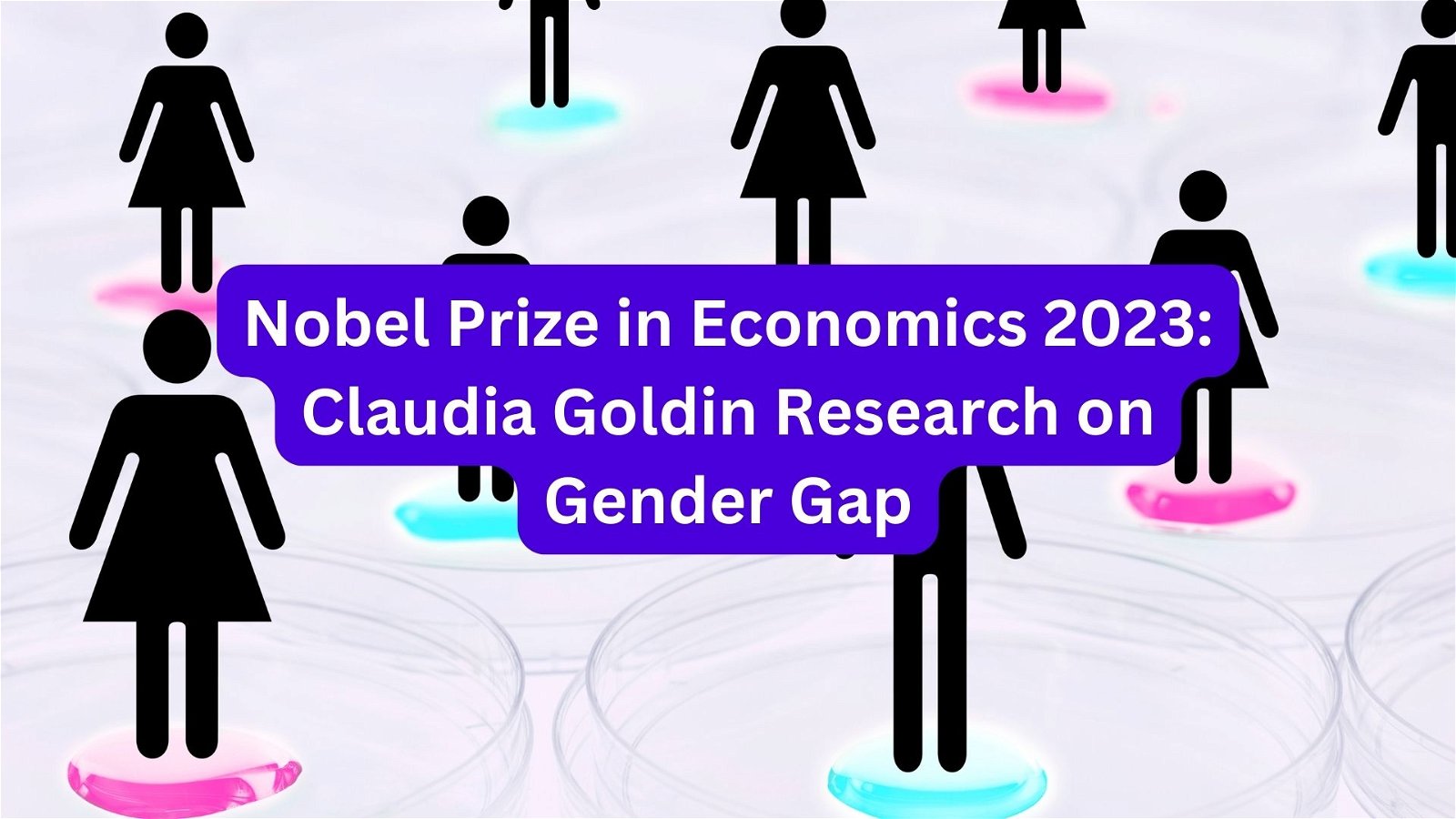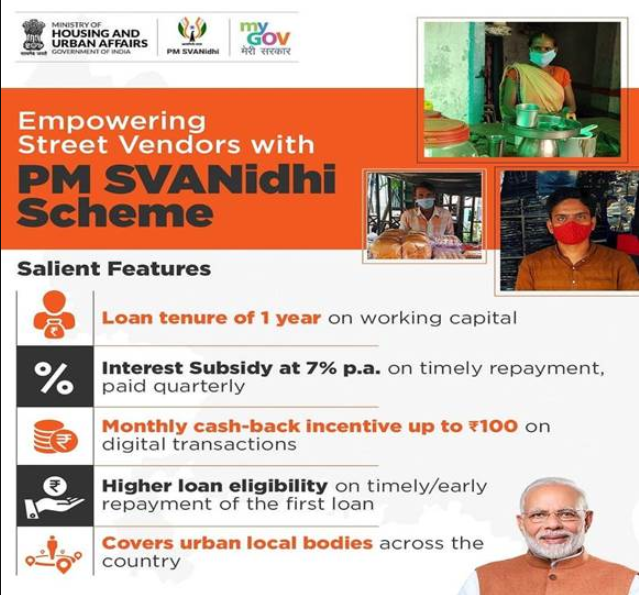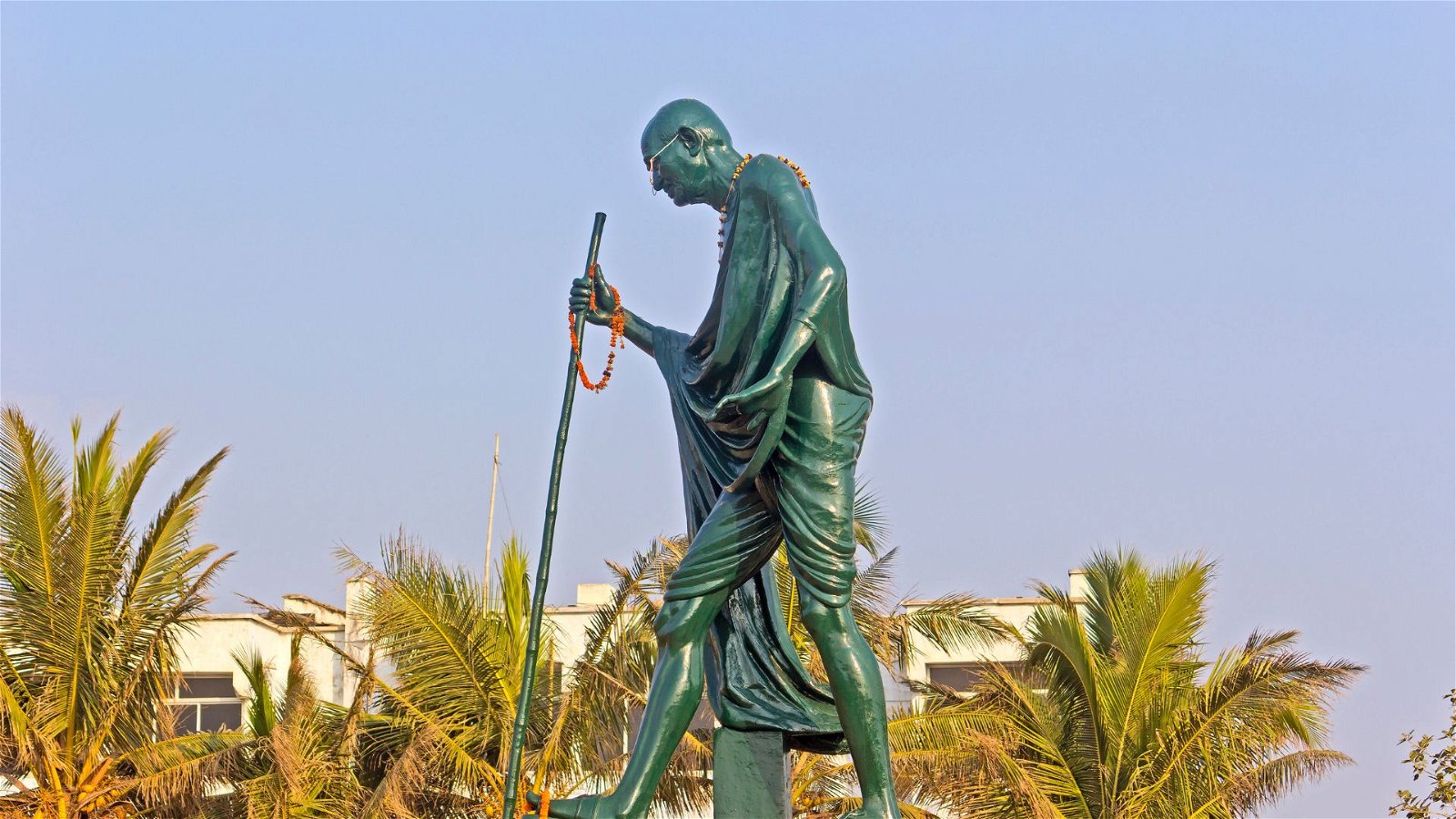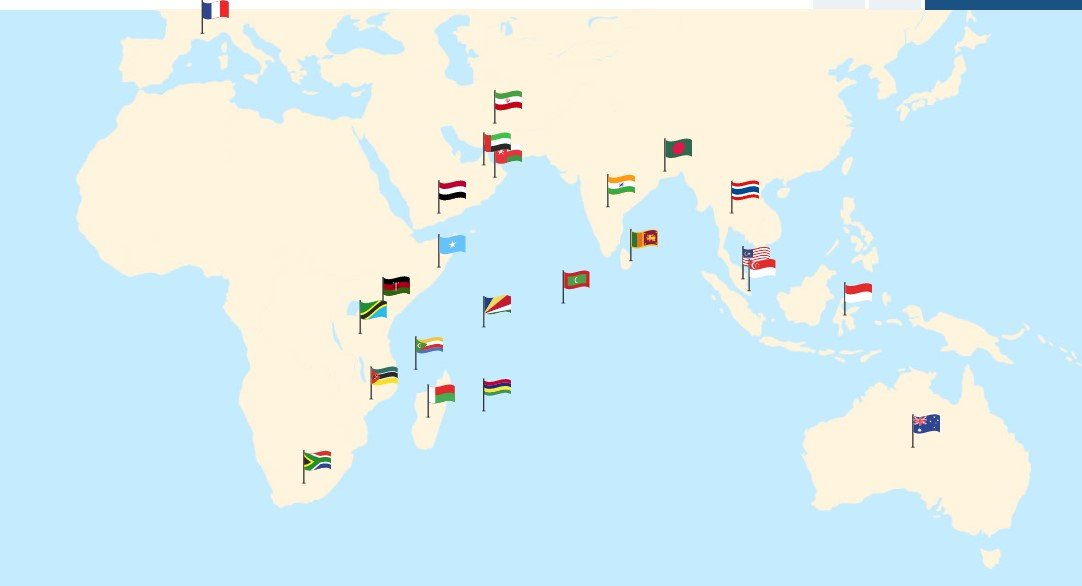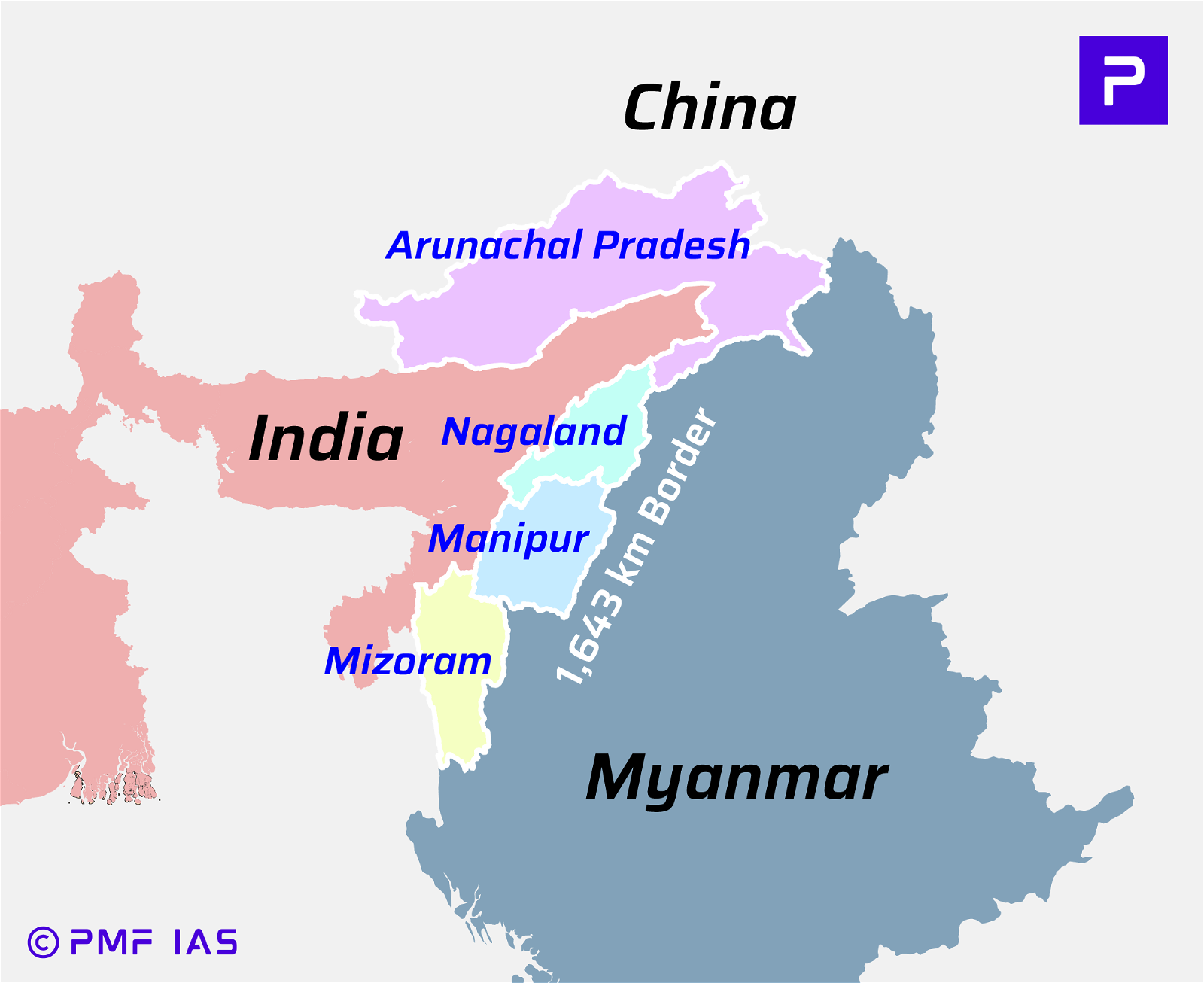
Current Affairs October 20, 2023: Formaldehyde, Regional Rapid Transit System, Severe Drought in Amazon, Shukrayaan-I, Red Tide
Subscribers of "Current Affairs" course can Download Daily Current Affairs in PDF/DOC
Subscribe to Never Miss an Important Update! Assured Discounts on New Products!
Must Join PMF IAS Telegram Channel & PMF IAS History Telegram Channel
{GS1 – Geo – PG – Climatology} Severe Drought in Amazon Rainforest
- Context (IE | DTE | REUTERS | TG | BBC): The Amazon rainforest or Earth’s lungs is reeling from an intense drought accelerating the destruction of the Amazon.
|

Causes Behind the Severe Amazon Drought
El Nino
- El Nino is a climatic phenomenon of unusual warming of the eastern tropical Pacific Ocean.
- It is a part of the larger climatic phenomenon called El Nino-Southern Oscillation (ENSO).
- During El Nino, trade winds that normally blow from east to west weaken or even reverse direction.
- This alters atmospheric circulation, leading to reduced rainfall in typically wet Amazon rainforest.
High Sea Surface Temperatures
- The surface temperature of tropical North Atlantic Ocean is unusually high.
- Warmer ocean waters cause heated air to rise, reaching the Amazon rainforest.
- Warm air inhibits cloud formation, sharply reducing Amazon rainfall.
Deforestation for Agricultural Expansion and Logging
- Deforestation reduces the Amazon rainforest’s ability to regulate the climate and retain moisture.
- Moreover, deforestation contributes to rising temperatures, making droughts more accentuated.
Hydroelectric Dams
- Organic matter decomposition in dam reservoirs releases methane, a potent greenhouse gas.
- Deforestation and ecosystem disruption associated with dam construction can increase emissions of carbon dioxide and other pollutants.
|
Consequences of the Severe Amazon Drought
- Cutting of remote villages: Rapidly drying of rivers have left boats stranded, cutting off food, water, and medicine supplies to remote villages
- Dying of aquatic organisms: Low water level and high water temperatures have killed high numbers of fish and river dolphins including pink dolphins and tucuxis (or grey dolphins).
- Contamination of water: The rotting of aquatic organisms carcasses killed by drought have contaminated the water supply in some areas.
- Stalled hydropower dams: The lack of water has also stalled the operations of hydropower dams.
- Wildfires: The extreme dry conditions have made Amazon rainforest more vulnerable to wildfires. In only October month, the Amazonas state has witnessed 2,700 blazes.
- Poor air quality: Smoke from wildfires has plummeted air quality to hazardous levels in some areas.
Amazon Rainforests
Amazon River
|
{GS1 – MIH – Personalities} Syed Ahmad Khan
- Context (IE): Sir Syed Ahmad Khan was the most important reformer among the Muslims.
- He was impressed by modern scientific thought and worked to spread modern education among Muslims throughout his life.
- He interpreted the Quran in the light of contemporary rationalism and science.
- He urged the people to develop a critical approach and freedom of thought.
- He was against fanaticism, narrow-mindedness, and exclusiveness and urged students and others to be broadminded and tolerant.
- He was a religious tolerant person and considered religion as one’s private affair.
- He was also opposed to communal friction. Appealing to Hindus and Muslims to unite.
- His progressive social ideas were propagated through his magazine Tahdhib–ul-Akhlaq.
- He condemned polygamy and was in favour of:
- Raising the social status of women
- Education for women
- Removal of purdah.
Role in the Spread of Education
- He believed that the religious and social life of the Muslims could be improved only by imbibing modern Western scientific knowledge and culture.
- He founded schools in many towns and translated Western books into Urdu.
- In 1875, he founded the Muhammedan Anglo-Oriental College at Aligarh as a centre for spreading Western sciences and culture. It was open to all Indians.
- Later, it grew into the Aligarh Muslim University (the first Muslim university in Southern Asia).
- He believed that only by becoming as modern as the English could Indians successfully challenge foreign rule.
- Hence, he advised all Indians, especially educationally disadvantaged Muslims, to abstain from politics for a while. This prevented his followers from joining the national movement.
- He had become so committed to his college and the cause of education that he was willing to sacrifice all other interests for them.
- Consequently, to prevent the orthodox Muslims from opposing his college, he virtually gave up his agitation in favour of religious reform.
Role in Encouraging the Communalism
- He felt that hostility with the British might harm educational efforts.
- For the same, he would not do anything to offend the government. Because of this attitude, he encouraged communalism and separatism.
- Towards the end of his life, he began talking about Hindu domination and prevented his followers from joining the national movement.
{GS2 – Health – Issues} Formaldehyde
- Context (LM): The Food and Drug Administration has proposed to ban formaldehyde containing hairstraightening products because of their carcinogenic effects.
- Formaldehyde (CH2O) is a colourless, pungent, and highly reactive gas at room temperature.
- Formaldehyde are used in:
- Resins used in the manufacture of composite wood products (i.e., plywood, particleboard, etc)
- Building materials and insulation
- Household products such as glues, permanent press fabrics, paints and coatings, paper products
- Cosmetics, hygiene, and detergents products like dishwashing liquids and fabric softener
- Preservatives in mortuaries and medical laboratories
- Fertilizers and pesticides
- It is a byproduct of combustion :
- Emissions from unvented, fuel burning appliances, like gas stoves or kerosene heaters
- Cigarette smoke
- It is also produced naturally during the decay of plant material in the soil and during normal chemical processes in most living organisms.
- Adverse health effects of formaldehyde:
- Respiratory Diseases
- Allergic Reactions
- Cancer
{GS2 – Polity – IC – Judiciary} Appointment of Judges
- Context (TH): The SC said when there are differences between the SC and the government, it may not be “advisable” to hold up the entire judicial appointment process.
- Under Article 124 of IC, the President appoints the CJI and the Judges of the SC.
- Currently, the SC Collegium, consisting of CJI and four senior-most judges, appoints SC judges.
|
Collegium system
- It is a group of the senior-most judges who appoint the judges of the higher judiciary.
- The collegium system doesn’t find any mention in IC.
- Its legal basis is in three judgments called ‘Judges Cases’.
- These judgments made their way into the present Memorandum of Procedure to appoint judges.
First Judges case (1981)
- The SC decided that the recommendation of the CJI did not bind the President.
Second Judges case (1993)
- The SC reversed its decision and held that “consultation” means “concurrence”, and the President would be bound by the advice of the CJI.
- It introduced the collegium system. As per that, the opinion of the SC or HC chief justice would be formed by consultation with two senior-most judges from that court.
Third Judges case (1998)
- SC clarified that the SC Collegium must have the CJI and the four senior-most judges from the SC.
National Judicial Appointments Commission (NJAC)
- The 99th Constitutional Amendment Act of 2014 establishes the NJAC.
- NJAC was established to select, appoint, and transfer judges to the higher judiciary.
- In 2015, a Constitution Bench of the SC struck down the constitutional amendment.
- The SC said that the NJAC subverted the independence of the judiciary.
Article 50 of IC: Separation of judiciary from the executive
|
Memorandum of Procedure (MoP) of Appointment of SC Judges
Justice of India (CJI)
- The senior–most Judge of the SC who is considered fit to hold the office should be appointed as CJI.
- The Union Minister of Law, Justice and Company Affairs would seek the recommendation of the outgoing CJI to appoint the next CJI.
- Once the CJI’s recommendation is received, the Union Minister of Law, Justice, and Company Affairs will forward it to the PM, who will then advise the President.
- Whenever there is any doubt about the seniormost Judge’s capability to hold the CJI’s office, the other Judges will be consulted to ensure the right appointment for the position of the next CJI.
Judges of SC
- When a vacancy is expected in the office of Judges SC, the CJI initiates a proposal and forwards recommendations to the Union Minister of Law to appoint a new Judge.
- The CJI will make a recommendation after consulting with a collegium of the four seniormost Judges of the SC. If the successor CJI is not one of the four seniormost Judges, he will be included in the collegium.
- The CJI will seek the opinion of the seniormost Judge in the SC who comes from the same HC as the recommended person. If that judge doesn’t know enough, the next senior Judge from that HC in the SC should be consulted.
- The opinion of CJI and all concerned members would be made in writing. The CJI will forward this to the GoI. Once the CJI’s final recommendation is received, the Union Minister of Law will present the recommendations to the PM, who will then advise the President on the appointment.
Revised MoP
|
Issues with the Appointment of Judges
- The Collegium’s functioning has been criticised for being opaque.
- It does not have fixed criteria to evaluate the judges considered for appointment to the SC.
- It fails to fulfil basic demands of transparency and accountability and remains prone to charges of nepotism.
- The GoI is sitting on recommendations. It would affect the seniority of judges.
- The GoI ignored reiterations by the collegium, which, as per the law, are binding on the government.
- Lack of social diversity in the appointments of Judges.
|
Way forward
- Though the collegium system is flawed, the Judiciary in the hands of the executive is a threat to the existence of the judiciary.
- The SC should voluntarily take up reforms to the collegium system and create a new MoP by incorporating the legitimate concerns of the government and stakeholders.
{GS2 – Polity – IC – State Legislature} Money Bill
- Context (TH): The Punjab governor withheld approval for the money Bills.
- The money bills were sent to the governor for approval to be presented in the Special Session, which will be an extension of the Budget Session.
|
Options of the Governor on State Bills (Assent, Withholding, Return, and Reservation)
- When a Bill passed by the State Legislative Assembly is presented to the Governor, the Governor can choose to:
- Give assent to the Bill.
- Withhold assent.
- Return the Bill (except if it’s a money Bill)
- Reserve the Bill for the President’s consideration.
- If a returned Bill is passed by the House again, the Governor can either:
- Give assent to the Bill.
- Reserve the Bill for the President’s consideration.
Special Provisions for Money Bill
- A Money Bill cannot be introduced in State Legislative Council. It can only be introduced in the State Assembly with the prior recommendation of the Governor for introduction.
- The Governor cannot return the Money Bill when it is presented for its assent.
|
{GS3 – Agri – Subsidies} Minimum Support Price
- Context (LM I IE I TI): The government raised six rabi crop MSPs, with increases ranging from 2% to 7%, for the 2024-25 marketing season.
- MSP for wheat and Masur prices increased by a maximum of 7%, followed by barley (6.6%), mustard and rapeseed (3.6%), safflower (2.6%) and chana (gram) (2%).
- For wheat, this is the highest spike since the same level of increases in the two consecutive crop years of 2006-07 and 2007-08 during the previous United Progressive Alliance (UPA) regime
Political Implications
- Politically, this is the last increase before the 2024 Lok Sabha elections and preceding next month’s state assembly polls. Wheat is a crucial rabi crop in states like Madhya Pradesh and Rajasthan.
- Over a decade, the Modi government has increased the MSP for wheat by Rs 875 per quintal, exceeding the Rs 770 increase during the UPA’s tenure.
- Similar trends are seen in common paddy (Rs 873 versus Rs 760 per quintal).
Economic Concerns
- The current MSP increase is mainly driven by the abundance of wheat stocks in warehouses, amounting to 239.95 lakh tonnes (lt), slightly above the normative minimum of 205.2 lt.
- There are also concerns for the new crop, as major reservoirs have lower water levels than last year or the 10-year average.
- Additionally, a strengthening El Niño could impact rabi season rainfall.
- The government aims to ensure a stable supply during national elections.
Critique of MSP Hike
Wheat in India doesn’t need incentivisation
- Firstly, wheat is a default crop for farmers with irrigation access in northern and central India.
- So, they don’t require extra incentives to grow it. Wheat covers a significant portion of the total rabi crop area in the country.
Option of Import Substitution
- In the face of tight supplies, the Government can import wheat, as prices have fallen significantly in the international market.
- The increase in MSP is more influenced by political considerations than economic necessities.
Minimum Support Price
- Minimum Support Price (MSP) is a minimum price set by the government for certain agricultural commodities to protect farmers from fluctuations in market prices and ensure a minimum income level for their produce.
- Simply, the MSP is the rate at which the government buys grains from farmers.
- The Central government fixes the MSPs on the recommendations of the Commission for Agricultural Costs and Prices (CACP) under the Ministry of Agriculture.
- After receiving the feedback, the Cabinet Committee on Economic Affairs (CCEA) of the Union government decides on the level of MSPs.
- The Food Corporation of India (FCI), the nodal agency, along with other State Agencies, undertakes procurement of crops.
- The MSPs are announced before the sowing season by the government.
- The government is not legally bound to pay the MSP to farmers.
- So, though the government encourages the procurement of crops at MSP through its agencies, there is no legal obligation for the government to purchase all crops at MSP or to compensate farmers if market prices fall below the MSP.
- GoI fixes MSPs for 23 farm commodities based on CACP recommendations:
- In addition, GoI also fixes the MSP of toria and de-husked coconut based on the MSPs of rapeseed/mustard and copra, respectively.
|
MSP Recommended by CACP |
|
| 7 cereals | paddy, wheat, maize, sorghum, pearl millet, barley, ragi |
| 5 pulses | gram, tur, moong, urad, lentil |
| 7 oilseeds | groundnut, rapeseed-mustard, soybean, sesamum, sunflower, safflower, nigerseed |
| 4 commercial | copra, sugarcane, cotton, raw jute |
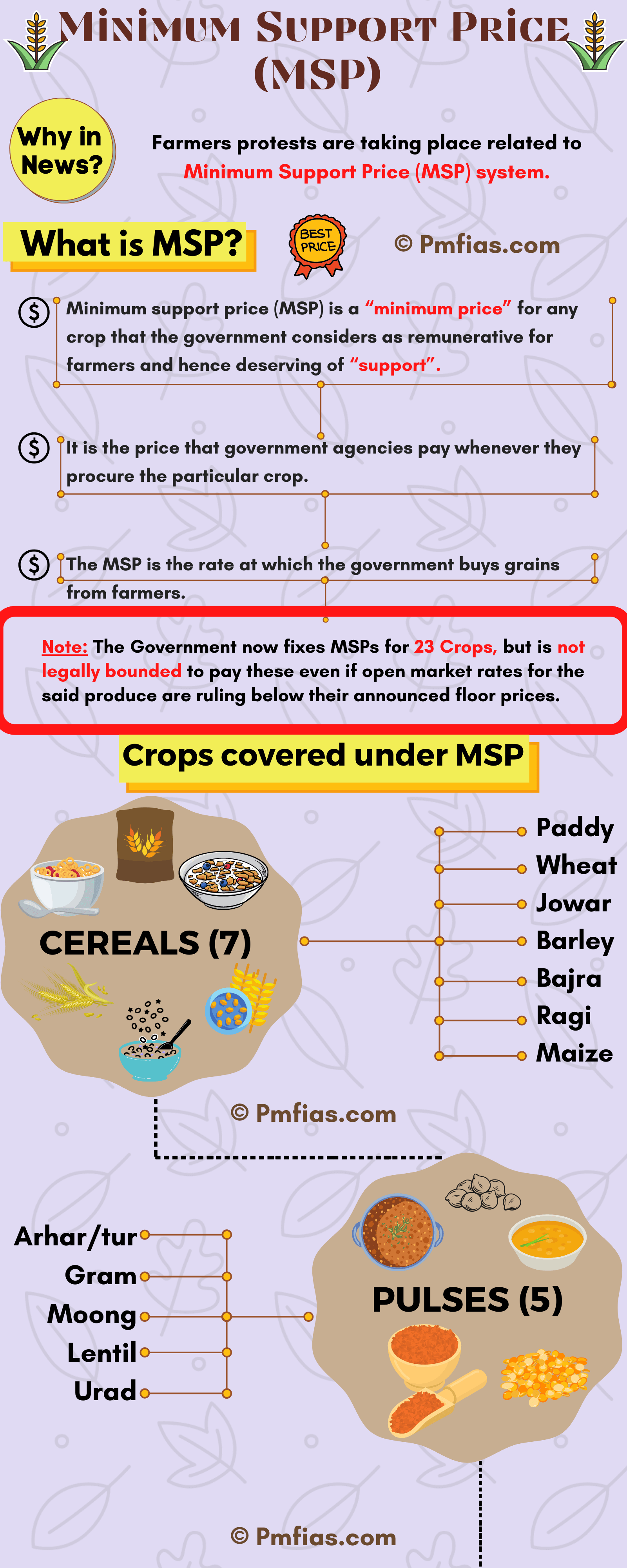

Fair and Remunerative Price (FRP)
- With the amendment of the Sugarcane (Control) Order, 1966 in 2009, the SMP of sugarcane was replaced with the Fair and Remunerative Price (FRP) of sugarcane.
- The amendment added a new clause for working out FRP by CACP.
|
Fair and Remunerative Price (FRP) |
Minimum Support Price (MSP) |
| FRP is the minimum price at which sugar mills purchase sugarcane from farmers. | MSP is the minimum price at which certain agricultural products are directly procured from farmers by the GoI. |
| It is mandated only for sugarcane. | It is mandated for kharif crops (14), rabi crops (6), and other commercial crops. |
| FRP is governed by the statutory provisions of the Sugarcane (Control) Order, 1966, issued under the Essential Commodities Act (ECA), 1955. | Any statutory provision does not govern MSP.
It is simply an obligatory exercise. |
| Both FRP and MSP are declared by the GoI based on the recommendation of the Commission for Agricultural Costs and Prices (CACP). | |
{GS3 – Envi – Conservation} Red Tide in Puducherry
- Context (TH | TH): Red tide,a harmful algal bloom, resulting in a reddish tinge on the Promenade Beach in Puducherry.
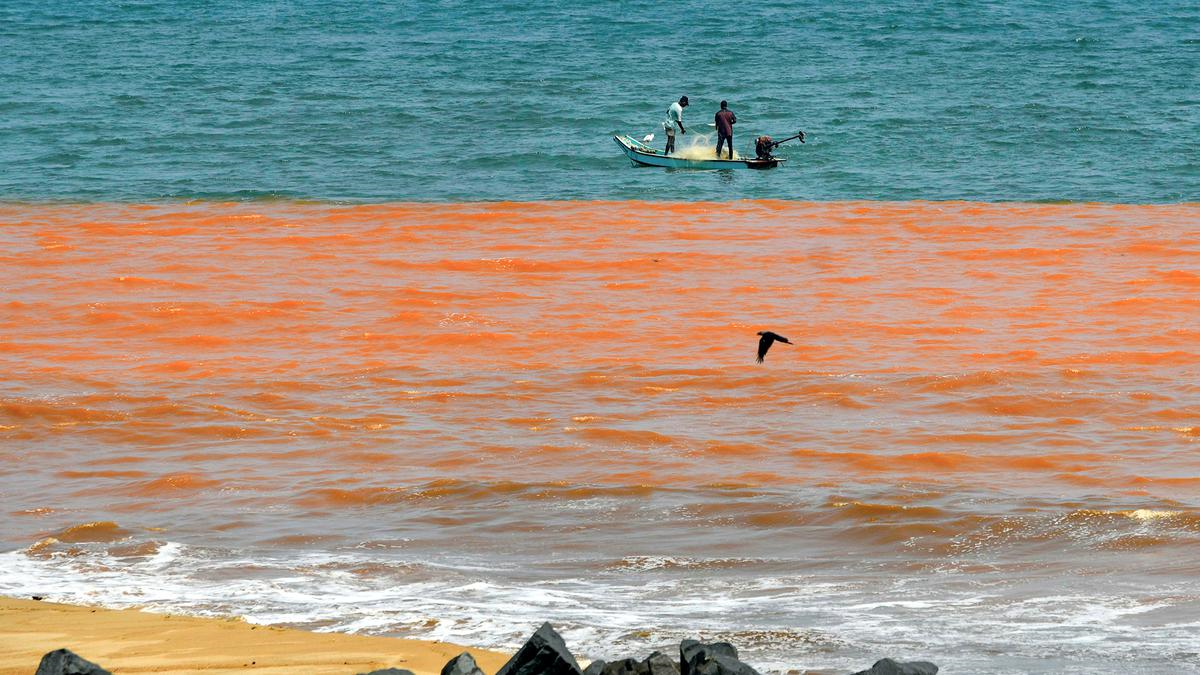
Harmful Algal Blooms (HABs)
- When colonies of algae grow uncontrollably and produce toxic or harmful effects on people, fishes, aquatic animals, and birds, it is called HAB. It occurs in both marine and freshwater sources.
- HABs are uncontrolled algae growth that produce toxic or harmful effects on organisms.
- They occur in both marine and freshwater sources.
- Marine HABs are caused by diatoms and dinoflagellates (like Karenia brevis). They are often called “red tides“ because algal blooms caused by dinoflagellates turn the water reddish-brown.
- Freshwater HABs are generally caused by blue-green algae or cyanobacteria.
Causes of HABs
- Eutrophication: Nutrient rich agricultural and urban runoff is a major reason for HABs.
- High Temperature
- Low Turbidity: Turbidity measures water’s loss of transparency due to suspended particles. Low turbidity fosters algal growth by enabling greater sunlight penetration.
- Reversal of ocean currents: It can trigger HABs through several mechanisms:
- Nutrient Redistribution
- Temperature Changes
- Stagnation
- Changes in Salinity
- Transport of Algal Cells
Impacts of HABs
- Health Issues
- Harm Aquaculture: Toxins from HABs contaminate marine organisms in aquaculture
- Dead Zones: Algal blooms deplete dissolved oxygen, causing dead zones (hypoxia) and blocking sunlight, harming marine life.
Mitigation of Effects of HABs
- Multiple Treatment of Effluents
- Nitrogen Testing and Modelling: It calculates the optimal fertilizer amount for crops, reducing nitrogen excess and preventing eutrophication.
- Organic Farming: It will reduce the nutrient richness of agricultural runoff.
- Reduction of Emission of Chemicals: Reducing nitrogen emissions from vehicles and power plants and use of phosphates in detergent.
{GS3 – IE – Infra – Transportation} Regional Rapid Transit System
- Context (IE I HT): PM will inaugurate the first leg of the Regional Rapid Transit System (RRTS), India’s first mass rapid system dedicated to regional connectivity.
- The Regional Rapid Transit System (RRTS) is an ambitious and integrated mass transit network to enhance connectivity and access across the National Capital Region (NCR).
- The RRTS is centered around semi-high-speed rail connectivity.
- The primary objective of the RRTS is to ensure “balanced and sustainable urban development” by improving transportation and accessibility within the NCR.
- Implementing Authority: The RRTS project is constructed and managed by the National Capital Region Transport Corporation (NCRTC).
|
- Namo Bharat Train: RapidX, the country’s first semi-high-speed regional rail service, has been renamed NaMo Bharat, a day before Prime Minister Narendra Modi is to inaugurate the train.
- Speed and Efficiency: RRTS trains are designed to operate significantly higher than traditional metro trains, with an operating speed of 160 km/hour and can run up to 180 km/hour.
- Corridors: The RRTS project envisions the development of eight corridors within the NCR. In the first phase of development, three corridors are being constructed:
- 82-km Delhi-Ghaziabad-Meerut corridor
- 164-km Delhi-Gurugram-SNB-Alwar corridor
- 103-km Delhi-Panipat corridor

Significance
- Faster Than Metros: This is particularly beneficial for commuters who need to cover relatively long distances across the NCR within a shorter time frame.
- Higher Frequency and Comfort: Compared to the Indian Railways, the RRTS covers relatively shorter distances but with higher frequency and offers a higher comfort level.
{GS3 – S&T – Defence} MQ-9B UAV
- Context (TH I IE): The MQ-9B Unmanned Aerial Vehicles (UAVs) deal with the U.S. is expected to be concluded by February 2024, and deliveries will begin in 2027.
- The MQ-9B is a High Altitude Long Endurance (HALE) UAV and boosts the armed forces’ Intelligence, Surveillance and Reconnaissance (ISR) capabilities.
- It is designed to fly over the horizon via satellite for up to 40 hours in all types of weather and safely integrate into civil airspace.
- It can provide roughly 80% of the capability of a large human-flown maritime patrol aircraft at about 20% of its cost per hour.
- It can seamlessly integrate with other U.S.-origin platforms India operates, such as the P-8Is and Apache attack helicopters.
- It has two variants – Sky Guardian and Sea Guardian, its maritime variant.

{GS3 – S&T – ISRO} Shukrayaan-I
- Context (IE | TH | HT | LM | TP): After the success of Chandrayaan 3, ISRO’s target missions are:
- Shukrayaan–I
- Mars Lander Mission
- Bharatiya Antariksha Station (Indian Space Station) by 2035
- First Indian to the Moon by 2040
- Shukrayaan-I will be a Venus orbiter mission.
- Objectives:
- To study Venus’s geological structure and composition and volcanic activity
- To study the structure, composition, and dynamics of the atmosphere
- To investigate the solar wind interaction with the Venusian Ionosphere
- Launch vehicle: The mission will be launched either on GSLV Mk ll or GSLV Mk lll.
- Payloads:
- A high-resolution synthetic aperture radar
- A ground-penetrating radar
- Venusian Neutrals Analyzer (VNA): To investigate the interactions between charged particles emitted by the Sun and Venus’s atmosphere and exosphere.
|
Why the Launch Date of Shukrayaan-I is Being Pushed to 2031
- Shukrayaan I was expected to launch in December 2024.
- Optimal launch windows from Earth to Venus occur once every 19 months.
- But optimal launch windows that minimise liftoff fuel needs every 8 years, and 2031 is the next.
Other Venus Mission in the Queue
|
Reasons Why Venus is Difficult to Study
- Extreme Heat and Pressure: Venus, the hottest planet in the solar system, hit surface temperatures up to 464°C, and its atmospheric pressure is 90 times that of Earth.
- Dense Cloud Cover: Venus has thick sulfuric acid clouds that obscure visible light and hinder surface observation from space.
- Harsh Surface Conditions: Venus’ surface is harmful to landers and rovers due to scorching temperatures, acidic rain, toxic gases, and a corrosive environment.
- Limited Data Transmission: Venus’s proximity to the Sun poses challenges for transmitting data to Earth due to solar radiation interference.
|
Important Venus Missions |
|||
|
Mission Name |
Type |
Space Agency |
Significance |
| Mariner 2 | Flyby | NASA | First successful flyby past another planet |
| Venera 4 | Atmospheric | Lavochkin (USSR) | First successful Venusian atmospheric entry |
| Venera 7 | Lander | Lavochkin (USSR) | First soft landing on another planet (Venus) |
| Venera 9 | Orbiter/Lander | Lavochkin (USSR) | First orbiter of Venus. First images from the surface of another planet |
| Galileo | Flyby | NASA | Flyby en route to Jupiter |
| Cassini | Flyby | NASA | Flyby en route to Saturn |
| MESSENGER | Flyby | NASA | Flyby en route to Mercury |
| BepiColombo | Flyby | ESA/JAXA | Flybys en route to Mercury |
Other Facts About Venus
|
|||




![PMF IAS Environment for UPSC 2022-23 [paperback] PMF IAS [Nov 30, 2021]…](https://pmfias.b-cdn.net/wp-content/uploads/2024/04/pmfiasenvironmentforupsc2022-23paperbackpmfiasnov302021.jpg)


